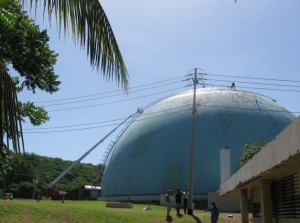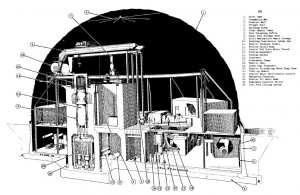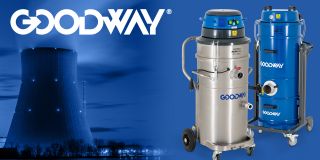Consolidation
While I was watching the Third Way Advanced Nuclear Summit on February 21, a wide range of topics was also being discussed on Twitter related to the various sessions. One of the things that was brought up was the large number of private companies and universities now engaged in the development of advanced reactors. It occurred to me-and I said as much on Twitter-that some consolidation of the industry was unavoidable. In fact, it's probably necessary. There's historical precedent for it.

BONUS nuclear plant; from U.S. DOE Inspection Report, 2013.
To the right we see a recent view of one of those original, experimental, and highly investigative Atomic Energy Commission (AEC) Power Demonstration Reactor Program plants dotted around the United States, which are both largely decommissioned and removed, as well as forgotten. This one however, has not been removed and is not in the United States. This is the BONUS-or BOiling NUclear Superheating experimental nuclear power plant-in Punta Higuera, Puerto Rico. It was designed, and its construction started, by a firebrand sort of startup company that did not survive. Well, not as an independent entity, anyway...and thereby hangs a tale.
Of all the people working with Enrico Fermi to construct and test the historic, "first-ever" nuclear reactor, the CP-1, was one of the standouts, Walter Zinn. Zinn would eventually progress from the triumph of this reactor to designing the next two (CP-2 and CP-3) to be designed by Argonne National Laboratory (ANL), and in fact, Zinn ended up in charge of ANL when Fermi departed.
Zinn would go on to become the first president of the American Nuclear Society in 1955, and in 1956 he and some of his friends left ANLto form a private company, which he titled General Nuclear Engineering Corporation (GNEC).
Certainly, with the accomplishments of ANL's reactor designs, the firm was set to succeed, and in 1958 it caught a big fish. A research and development (R&D) contract for the AEC to design a boiling water reactor that could also superheat steam. Since ANL already had heavy experience with BWRs, this seemed to be the right choice.

BONUS was unusual in having the reactor, spent fuel pool, turbine generator, and control equipment all inside the containment. Outside was the entry control building and administration. Illustration from report PRWRA-GNEC 6.
As the project progressed, something else happened-merger mania. The end of the 1950s saw many more companies interested in nuclear than exist today. There was getting to be an excess of everything from reactor vendors to instrumentation vendors, and everyone else interested in the field in between. As in any business field, the major companies had advantages (via large balance sheets) that allowed them to invest heavily in a field, for a period of time. They did so without the expectation of monetary return, although that happened eventually anyway. The smaller companies could not invest heavily, and thus were unable to take the large gambles. However, some of the smaller companies had concepts that looked promising to the larger companies, but those concepts were locked up as proprietary technology. So, between 1958 and 1960, a number of significant market dropouts occurred, as did a number of straight-out acquisitions and mergers. AMF Atomics dropped all power reactor plans, as one example, and Westinghouse dropped its research into commercial power aqueous homogenous reactors. Allis-Chalmers bought ACF Industries' entire nuclear business in that time period, obtaining a nuclear plant project still under construction (Elk River) and what appeared to be a lucrative research reactor business. (There were also a number of moves in the nuclear fuels manufacturing field at this time.)
Walter Zinn's GNEC was not immune from mergers either, and having an AEC developmental contract didn't hurt. Combustion Engineering (C-E) came away with the prize, agreeing to buy GNEC in 1959. It became a wholly-owned subsidiary of C-E until it was merged completely out of existence in 1964. Officially, cognizance over the BONUS project turned from GNEC to C-E, although Zinn and his people remained those most directly involved. It was reported at the time that several C-E executives left the company as they believed that Zinn and his people were being brought in to "take over." (There's no surer way to guarantee that you'll be replaced than to quit!)

BONUS plant under construction at Punta Higuera, Puerto Rico. From Combustion Engineering BONUS Completion Report.
Of course, what happened afterward is the point. The novel, important nuclear superheat reactor was said to be a great step up from conventional BWRs. Although the reactor allowed use of superheated steam plant equipment and auxiliaries (which are standard commercial non-nuclear items and are cheaper and had a much better overall efficiency), it was not carried beyond 1968 by AEC funding. The only other such reactor, of a very different design, had already failed (this was the Allis-Chalmers plant for the Pathfinder Atomic Power Plant). The direct lineage of BWRs that Zinn and his people carried from ANL was apparently dead.
However, what Zinn and his people did do was provide C-E with the kind of leadership and recognition in the nuclear field that it needed to move from simply being a supplier of components to others, with an occasional lead project position, to one of prominence as a reactor vendor. In fact, when the age of truly commercially viable nuclear plants opened in the mid-1960s, C-E was among the first to get orders for Nuclear Steam Supply Systems (NSSS)-even with no commercial nuclear plant experience other than BONUS. And it did so with a newly designed pressurized water reactor.
My point is quite simple. The original GNEC product of BWRs and the specific, advanced nuclear superheating experiment didn't work out. Surely, some original dreams died back then. What did happen is that when the real opportunity to sell nuclear plants came about, C-E was then in a position to provide PWR NSSS's, largely because of the acquisition of leadership that Zinn and his people brought to C-E. And nuclear plants were sold and constructed with C-E NSSSs and these ran for decades. Zinn really did make a large mark in commercial nuclear power-just not perhaps in the way he'd originally meant or with the technology he'd originally intended, and not with his name on the desk in the corner office.
I'm not suggesting that companies right now begin looking at with whom to merge, but I am saying that such ideas aren't bad, probably aren't too long in coming, and can result in better things, even if they're not the original vision.
Oh, one more thing-right in the middle of the BONUS project, the architect-engineer, Jackson & Moreland, was acquired by and merged into United Engineers and Constructors. What a coincidence-or a sign of the times.
 Will Davis is Communications Director and board member for the N/S Savannah Association, Inc. He is a consultant to the Global America Business Institute, a contributing author for Fuel Cycle Week, and he writes his own popular blog Atomic Power Review. Davis is also a consultant and writer for the American Nuclear Society, and serves on the ANS Communications Committee and on the Book Publishing Committee. He is a former U.S. Navy reactor operator and served on SSBN-641, USS Simon Bolivar.
Will Davis is Communications Director and board member for the N/S Savannah Association, Inc. He is a consultant to the Global America Business Institute, a contributing author for Fuel Cycle Week, and he writes his own popular blog Atomic Power Review. Davis is also a consultant and writer for the American Nuclear Society, and serves on the ANS Communications Committee and on the Book Publishing Committee. He is a former U.S. Navy reactor operator and served on SSBN-641, USS Simon Bolivar.

